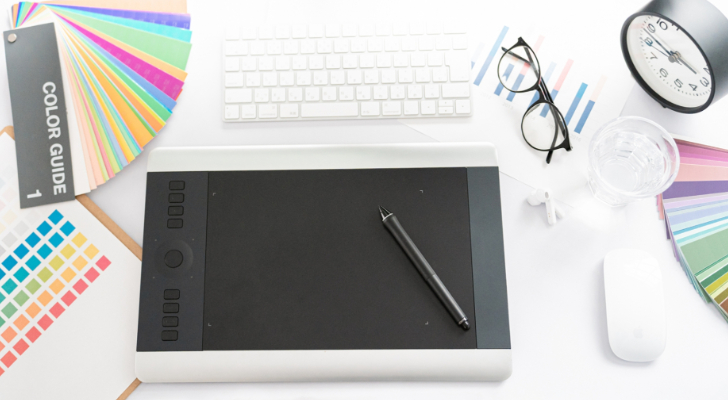
What grabs people’s attention in the digital world as well as in the physical world? It is hard to deny that graphic design play a big part. Memorable sign and product logos, vibrant banner ads, sleek layouts and appealing online displays – they all impact our online and real world experiences. How are these appealing graphical displays created?
It is graphic design software, which feature helpful tools that allow people of all skill levels and budgets to create high-quality designs.Simple online searches can help you discover robust and affordable graphic design software.
What Is Graphic Design Software?
This is a segment of computer software that is used to create visual content. You can think of it as the modern-day equivalent of an artist’s canvas, paints, and brushes. In the past, designers would need to sketch with pen and paper, transfer the designs through translucent sheets and choose colors from physical swatches. This is generally no longer the case. Graphic design software now allows all steps of the process to be done seamlessly on your device.
What Does Graphic Design Software Do?
You can break down what graphic design software can do into very specific design applications, packed with features.
- Vector and raster image editing: Edit images through actual pixel manipulation.
- Typography tools: Select, adjust, and fine-tune the text to get it just right.
- Color palette management: Craft the perfect color scheme.
- Layout and alignment tools: Ensure everything is in the right place.
- Drawing and illustration: Hand-draw designs or create digital illustrations.
From the design of an entire magazine to the graphics on the bag of your favorite potato chips, these software tools are being heavily utilized. Next time you admire a slick website design or an artsy book cover, remember there’s likely design software working hard behind the scenes.
Benefits of Using Graphic Design Software
Transitioning to graphic design software can be a game-changer. Whether you’re an experienced graphic designer or just casually developing a few ideas, the benefits of graphic design software can help you produce quality graphics:
- Efficiency and productivity: What once took hours can now be achieved in minutes, saving time and money.
- Precision and consistency: You can ensure that your designs have a uniform look and feel across varying platforms.
- More creativity: A large number of tools and features makes it easy for creativity to be unrestricted.
- Collaboration: Teamwork is now more streamlined with sharing and collective editing features.
- Professional results: Output is polished, refined, and top-tier.
The charm of traditional tools like pen and paper remains, but the advantages of graphic design software in professional settings are undeniably vast.
5 Popular Graphic Design Software Options
Now that we’ve explained why graphic design software is essential, let’s look at some of the top tools to keep in mind:
- Photoshop: A great solution for image editing. Whether it’s tweaking a family portrait or creating beautiful landscapes, Photoshop has the tools.
- Illustrator: This software focuses on vector graphics. Ideal for logos, icons, and scalable designs that retain quality irrespective of size.
- InDesign: From magazines to newspapers to brochures, InDesign is a top pick for layout and publishing graphic designs.
- CorelDRAW: A comprehensive suite, this offers a mix of vector artistry, layout, photo editing, and more.
- Canva: Tailored for beginners, this web-based platform offers design through intuitive templates and drag-and-drop functionalities.
With such a variety of software available, finding one that suits your needs is all about exploring and understanding your unique requirements.
Choosing the Right Software for Your Needs
So, with all these options, how do you pick the right one? It’s not a one-size-fits-all answer. Think about what you’ll be using it for, your level of expertise, and your budget:
- Beginner vs. professional: Some tools, are more user-friendly for those just starting, while some tools might have a steeper learning curve.
- Budget considerations: While some software comes with a high price or subscription fee, there are free and affordable alternatives available.
- Specific project needs: Do research on options that are available in different software packages to discover what software is right for you.
As designers evolve and learn, their software needs might also evolve. For this reason, there may be the need to upgrade or add more graphic design software to your toolkit in the future.
The Future of Graphic Design Software
As with everything tech-related, the world of graphic design software is always changing. There is an increasing move to mobile and tablet-based design tools, allowing designers to work anywhere. Augmented reality (AR) and virtual reality (VR) are making their way into the design process, offering immersive experiences. And artificial intelligence (AI) is helping automate repetitive tasks. Keeping up with these trends ensures you remain at the forefront of design.
The Bottom Line
Stepping back, it’s evident how integral graphic design software has become in shaping our visual world. Whether you’re a seasoned designer, a newcomer, or somewhere in between, understanding the tools of design offers a deeper appreciation of the craft. Dive in, explore, and don’t hesitate to experiment with different software. After all, creativity knows no bounds in the world of design.



